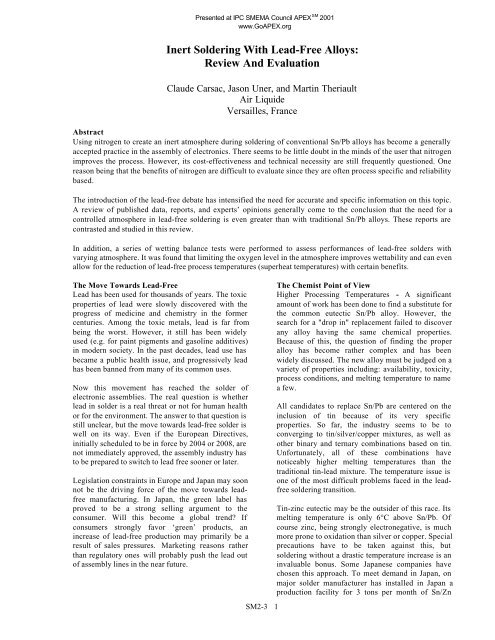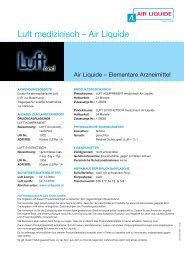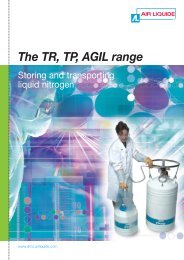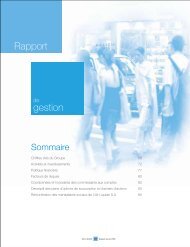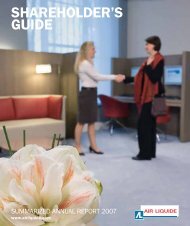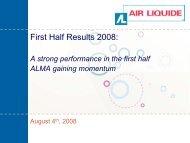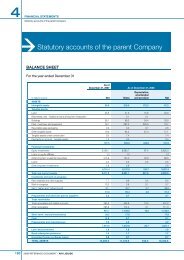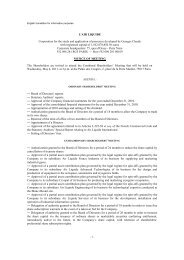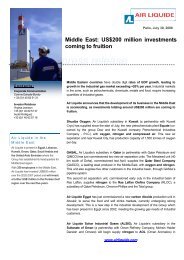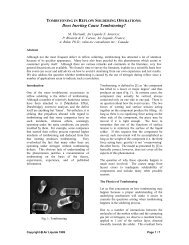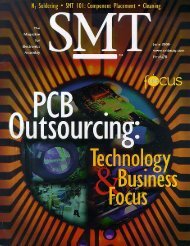Inert Soldering With Lead-Free Alloys: Review and Evaluation
Inert Soldering With Lead-Free Alloys: Review and Evaluation
Inert Soldering With Lead-Free Alloys: Review and Evaluation
Create successful ePaper yourself
Turn your PDF publications into a flip-book with our unique Google optimized e-Paper software.
<strong>Inert</strong> <strong>Soldering</strong> <strong>With</strong> <strong>Lead</strong>-<strong>Free</strong> <strong>Alloys</strong>:<br />
<strong>Review</strong> And <strong>Evaluation</strong><br />
Claude Carsac, Jason Uner, <strong>and</strong> Martin Theriault<br />
Air Liquide<br />
Versailles, France<br />
Abstract<br />
Using nitrogen to create an inert atmosphere during soldering of conventional Sn/Pb alloys has become a generally<br />
accepted practice in the assembly of electronics. There seems to be little doubt in the minds of the user that nitrogen<br />
improves the process. However, its cost-effectiveness <strong>and</strong> technical necessity are still frequently questioned. One<br />
reason being that the benefits of nitrogen are difficult to evaluate since they are often process specific <strong>and</strong> reliability<br />
based.<br />
The introduction of the lead-free debate has intensified the need for accurate <strong>and</strong> specific information on this topic.<br />
A review of published data, reports, <strong>and</strong> experts’ opinions generally come to the conclusion that the need for a<br />
controlled atmosphere in lead-free soldering is even greater than with traditional Sn/Pb alloys. These reports are<br />
contrasted <strong>and</strong> studied in this review.<br />
In addition, a series of wetting balance tests were performed to assess performances of lead-free solders with<br />
varying atmosphere. It was found that limiting the oxygen level in the atmosphere improves wettability <strong>and</strong> can even<br />
allow for the reduction of lead-free process temperatures (superheat temperatures) with certain benefits.<br />
The Move Towards <strong>Lead</strong>-<strong>Free</strong><br />
<strong>Lead</strong> has been used for thous<strong>and</strong>s of years. The toxic<br />
properties of lead were slowly discovered with the<br />
progress of medicine <strong>and</strong> chemistry in the former<br />
centuries. Among the toxic metals, lead is far from<br />
being the worst. However, it still has been widely<br />
used (e.g. for paint pigments <strong>and</strong> gasoline additives)<br />
in modern society. In the past decades, lead use has<br />
became a public health issue, <strong>and</strong> progressively lead<br />
has been banned from many of its common uses.<br />
Now this movement has reached the solder of<br />
electronic assemblies. The real question is whether<br />
lead in solder is a real threat or not for human health<br />
or for the environment. The answer to that question is<br />
still unclear, but the move towards lead-free solder is<br />
well on its way. Even if the European Directives,<br />
initially scheduled to be in force by 2004 or 2008, are<br />
not immediately approved, the assembly industry has<br />
to be prepared to switch to lead free sooner or later.<br />
Legislation constraints in Europe <strong>and</strong> Japan may soon<br />
not be the driving force of the move towards leadfree<br />
manufacturing. In Japan, the green label has<br />
proved to be a strong selling argument to the<br />
consumer. Will this become a global trend? If<br />
consumers strongly favor ‘green’ products, an<br />
increase of lead-free production may primarily be a<br />
result of sales pressures. Marketing reasons rather<br />
than regulatory ones will probably push the lead out<br />
of assembly lines in the near future.<br />
Presented at IPC SMEMA Council APEX SM 2001<br />
www.GoAPEX.org<br />
SM2-3 1<br />
The Chemist Point of View<br />
Higher Processing Temperatures - A significant<br />
amount of work has been done to find a substitute for<br />
the common eutectic Sn/Pb alloy. However, the<br />
search for a "drop in" replacement failed to discover<br />
any alloy having the same chemical properties.<br />
Because of this, the question of finding the proper<br />
alloy has become rather complex <strong>and</strong> has been<br />
widely discussed. The new alloy must be judged on a<br />
variety of properties including: availability, toxicity,<br />
process conditions, <strong>and</strong> melting temperature to name<br />
a few.<br />
All c<strong>and</strong>idates to replace Sn/Pb are centered on the<br />
inclusion of tin because of its very specific<br />
properties. So far, the industry seems to be to<br />
converging to tin/silver/copper mixtures, as well as<br />
other binary <strong>and</strong> ternary combinations based on tin.<br />
Unfortunately, all of these combinations have<br />
noticeably higher melting temperatures than the<br />
traditional tin-lead mixture. The temperature issue is<br />
one of the most difficult problems faced in the leadfree<br />
soldering transition.<br />
Tin-zinc eutectic may be the outsider of this race. Its<br />
melting temperature is only 6°C above Sn/Pb. Of<br />
course zinc, being strongly electronegative, is much<br />
more prone to oxidation than silver or copper. Special<br />
precautions have to be taken against this, but<br />
soldering without a drastic temperature increase is an<br />
invaluable bonus. Some Japanese companies have<br />
chosen this approach. To meet dem<strong>and</strong> in Japan, on<br />
major solder manufacturer has installed in Japan a<br />
production facility for 3 tons per month of Sn/Zn
solder paste. 1 Bismuth use may also help avoid the<br />
temperature issue, but the “lifting” effect needs to be<br />
addressed.<br />
There is a definite move toward a st<strong>and</strong>ard alloy in<br />
the US <strong>and</strong> Europe. The best c<strong>and</strong>idates are<br />
combinations of the above mentioned metals: Sn, Ag<br />
<strong>and</strong> Cu. 2,3 All of those combinations have melting<br />
points ranking from 34 to 44°C above Tin-lead<br />
eutectic. Due to this fact, electronics manufacturers<br />
will most likely have to face a non-negligible<br />
increase in their processing temperatures.<br />
Increased Oxidation & Flux Issues - Higher<br />
processing temperatures are a serious issue for the<br />
PCBs as well as for the components. Since electronic<br />
soldering has been done, the technology has been<br />
stabilized around the melting point of tin-lead.<br />
Reflow ovens <strong>and</strong> wave soldering processes will need<br />
to be modified to account for the new solder<br />
materials. Once this is done, the greatest impact of<br />
the increased operating temperature, an increase in<br />
oxidation, will be seen.<br />
The science of soldering relies heavily wetting,<br />
which is reduced by oxidation. An overall increase in<br />
oxidation will adversely affect soldering. One could<br />
state that a 10-degree temperature increase is small,<br />
but considering Arrhenius law, the growth in reaction<br />
rate is exponential <strong>and</strong> thus very significant in terms<br />
of oxide layer thickness.<br />
To reduce the effect of oxidation <strong>and</strong> allow for<br />
sufficient wetting, flux is used in soldering. Flux<br />
formulations are often delicate blends of carefully<br />
chosen organic compounds <strong>and</strong> solvents. The<br />
tolerance of those organic compounds to elevated<br />
temperatures is fairly limited. Organic compounds<br />
are prone to "cook" or "bake" in high temperatures<br />
thereby loosing the chemical properties for which<br />
they have been added to the flux. The solvents will<br />
also evaporate faster when the temperature is raised.<br />
In reference to lead-free soldering 4 , it was found that<br />
higher preheat temperatures promote slumping, the<br />
spread of solder paste, <strong>and</strong> a more rapid deactivation<br />
of the acids used in fluxes. It can also be added that at<br />
higher temperatures, the flux layer protecting the<br />
metal will be thinner, thus increasing the potential<br />
oxidation rate of the solder as well as of the metal on<br />
the pads or leads being soldered. Moreover, the<br />
components of the flux will also oxidize <strong>and</strong>/or<br />
polymerize. After soldering, this may leave a<br />
brownish <strong>and</strong> hard to remove mix of chemically<br />
undefined compounds. Whether those compounds are<br />
or not a threat to the reliability of the end product is<br />
an open question.<br />
SM2-3 2<br />
The Benefit of an <strong>Inert</strong> Atmosphere - Flux <strong>and</strong> solder<br />
paste manufacturers do not remain inactive when<br />
facing the challenge of the higher temperatures<br />
required by lead-free solders. They continue to<br />
modify <strong>and</strong> experiment with new <strong>and</strong> stronger flux<br />
formulations. Increased solid content <strong>and</strong> higher<br />
boiling temperature solvents are common answers.<br />
However, newer <strong>and</strong> stronger formulations may raise<br />
some issues related to the post-soldering residue<br />
formation. These residues may be more difficult to<br />
clean or may be harmful if left on the finished<br />
product. As we move towards more complex<br />
products <strong>and</strong> board designs, not cleaning potentially<br />
harmful residues may cease to be an option.<br />
One solution to the increase of temperature <strong>and</strong><br />
oxidation, while still allowing for the use of st<strong>and</strong>ard<br />
or less aggressive flux formulations, is to reduce the<br />
oxygen content in the solder step by inerting the<br />
reflow oven or the wave solder equipment. Providing<br />
a low ROL (Residual Oxygen Level) in the soldering<br />
area will help protect metal <strong>and</strong> flux against<br />
excessive oxidation while promoting better wetting.<br />
The only drawback to such an answer is the cost of<br />
the nitrogen used for inerting. Although nitrogen<br />
consumption of soldering equipment has been greatly<br />
lowered, the added cost still requires that the use of<br />
nitrogen be fully justified.<br />
<strong>Inert</strong> <strong>Soldering</strong>: Experts’ Opinions<br />
Among the growing amount of literature dedicated to<br />
the lead-free issue, we have searched for published<br />
material related to nitrogen use <strong>and</strong> inert soldering.<br />
The information published is important <strong>and</strong> can help<br />
the assembler improve his knowledge of lead-free<br />
soldering in order to make the appropriate decisions.<br />
Professional Press <strong>and</strong> Consultants<br />
In a recent article, 5 the use of nitrogen is questioned<br />
in the reflow of Pb alloys. The article has the opinion<br />
that while an inert atmosphere in reflow may help, its<br />
cost may not be justified. However, for wave<br />
soldering, it gives a different analysis. It should be<br />
noted that the article does state that if the process<br />
window is significantly impinged upon, there should<br />
not be any hesitation to use an inert atmosphere.<br />
In another article, 6 focusing on nitrogen atmosphere,<br />
develops a recipe as to when or when not to use N2<br />
in Pb systems. The forgiving qualities of nitrogen<br />
may prove useful when certain conditions such as<br />
high temperature solder, fine pitch, complex<br />
assemblies, or high product reliability are involved.<br />
<strong>Lead</strong>-free soldering does involved high temperatures,<br />
<strong>and</strong> future products will involve smaller, more<br />
complex designs while using lead-free solders.
Gas manufacturers<br />
Gas manufacturers generally admit that using<br />
nitrogen should be done selectively <strong>and</strong> based on<br />
process criterias. One particular benefit could be that<br />
nitrogen use for lead-free solder systems could allow<br />
soldering to be performed at just a few degrees above<br />
the solder melting point. 7 The objective being to<br />
reduce the heat stress seen by the component which is<br />
now among the predominant issues of lead-free<br />
soldering.<br />
This is also supported by an example where six leadfree<br />
solders were tested with a clear focus on the<br />
"Superheat Temperature” (ST). 8 The ST can be<br />
defined as the difference between the melting point<br />
of the alloy <strong>and</strong> the process temperature used to<br />
solder it. Again, it is concluded that nitrogen can<br />
reduce the ST for reflow, therefore allowing for a<br />
reduction in the proposed increase in soldering<br />
temperature required with lead-free solders.<br />
Flux <strong>and</strong> Solder Paste Manufacturers<br />
These companies are directly on the forefront of the<br />
lead-free issue <strong>and</strong> most of the published data on this<br />
topic is coming from them. Various publications, as<br />
well as commercial technical brochures, generally<br />
indicate that flux <strong>and</strong> solder pastes are formulated to<br />
give good results with both air <strong>and</strong> nitrogen. Nitrogen<br />
atmosphere must be avoided [for cost reasons] but it<br />
might not always be possible. 9<br />
Others focus on the poor wetting properties generally<br />
encountered with lead-free alloys but state that the<br />
interest of nitrogen is marginal. 10 A slightly different<br />
opinion is to recognize that increased oxidation<br />
promotes nitrogen use, but then insist that for their<br />
own flux formulations, nitrogen is an advantage but<br />
is not essential. 11 Some opinions are more openly in<br />
favor of nitrogen stressing the poor wetting properties<br />
of the Sn/Ag/Cu series of alloys with commercial <strong>and</strong><br />
especially no-clean fluxes, 12 or insisting on the<br />
possibility of using nitrogen to avoid cleaning<br />
issues. 13 A difference has to be made between reflow<br />
<strong>and</strong> wave soldering for which the nitrogen benefit of<br />
the former is apparently not discussed. 14<br />
Other interesting technical opinions encountered<br />
include: flux residues oxidizing during processing in<br />
air to a state where they are difficult to clean vs. N2, 9<br />
nitrogen being used successfully for hot gas repair,<br />
<strong>and</strong> nitrogen reducing oxidation simplify the process<br />
control. 15 Nitrogen is also recommended in zincbearing<br />
solders. 16<br />
Equipment Manufacturers<br />
Publications by these companies in the lead-free area<br />
are less common. One study did find the opinion of a<br />
manufacturer who is clearly in favor of nitrogen. 17<br />
The main argument is that given the fact that we do<br />
SM2-3 3<br />
not want to use active fluxes <strong>and</strong> subsequent<br />
cleaning, the quality of the nitrogen atmosphere may<br />
become even more important for Pb-free alloys than<br />
it has been with the st<strong>and</strong>ard Sn/Pb solder.<br />
The same source also emphasizes the efforts made<br />
recently to lower the nitrogen consumption of reflow<br />
ovens <strong>and</strong> wave soldering machines. Figures are<br />
given to obtain a ROL of 150ppm. The typical<br />
consumption is now below 27Nm 3 /h (1000 scfh) in<br />
reflow rather than the 55–80 Nm 3 /h (2000-3000 scfh)<br />
commonly encountered in older N2-capable reflow<br />
ovens.<br />
Users<br />
Many assemblers are spending time testing lead-free<br />
solutions on part of their own production. For evident<br />
reasons, data is not willingly shared or published.<br />
Nevertheless, some indications can be found in the<br />
published material.<br />
The majority of assemblers try to work without<br />
nitrogen for cost reasons. 11 Important R&D efforts<br />
have especially been made in Japan to obtain<br />
acceptable results using air, even in adverse<br />
conditions with Zinc containing solders. 18 However,<br />
others that have tried nitrogen have disclosed their<br />
experience concluding to the necessity to use inert<br />
atmosphere for telephone assemblies. 19<br />
Professional Organizations <strong>and</strong> Research<br />
InstitutesFor these organizations, under less<br />
commercial pressure, the opinion is more widely in<br />
favor of nitrogen inerting for wave as well as for<br />
reflow. “Nitrogen inerting may become of critical<br />
importance in the future with the uptake of lead-free<br />
alloys.” 20 Several sources report that the use of a<br />
nitrogen atmosphere can allow a reduction in the<br />
peak soldering temperature, 2,21 thus confirming that<br />
inert soldering is a possible way to address the issue<br />
of higher temperatures in lead-free soldering.<br />
The use of nitrogen is also specifically stressed for<br />
complex boards with a high thermal dem<strong>and</strong> <strong>and</strong> a<br />
large range of temperatures across the board. 20 Is it<br />
also stressed for varying finishes <strong>and</strong> thermal<br />
requirements. 2 For such boards, nitrogen is<br />
recommended.<br />
The Cost Issue<br />
It is generally agreed that lead-free implementation<br />
will unavoidably result in an increase of production<br />
costs. It might be interesting to analyze this cost<br />
increase in order to work to minimize it. In one<br />
example, 11 a simulation shows that the cost of the<br />
soldering material is less than 0.1% of the cost of the<br />
electronic end product. In fact, utilities or nitrogen<br />
are typically less than 0.1% of the finished product<br />
cost.
Another very interesting result of this simulation is a<br />
list of the most important contributors to the cost<br />
increase associated with lead-free implementation. At<br />
the top of this list, as far as this can be estimated, are<br />
typically the implementation costs for the new<br />
process, the slower cycle times applied to the new<br />
thermal profiles, <strong>and</strong> in particular the unavoidable<br />
reduction of product yields. Can nitrogen become a<br />
low cost insurance when implementing a new process<br />
with an unavoidably shrinking process window?<br />
The Specific Case of Wave <strong>Soldering</strong><br />
One of the primary differences between wave <strong>and</strong><br />
reflow soldering is the creation of dross. Dross is<br />
formed in wave soldering when the molten wave of<br />
solder comes in contact with the oxygen contained in<br />
the air. Naturally, the use of an inert atmosphere<br />
SM2-3 4<br />
largely eliminates the creation of dross, preventing a<br />
large amount of solder from being wasted.<br />
How does lead-free modify this situation? An<br />
interesting answer to that question can be found in<br />
research work performed some years ago in<br />
Engl<strong>and</strong>. 23 Extracted from this reference, Table 1<br />
shows the cost of the dross estimated for a<br />
commercial wave soldering machine with different<br />
solders while comparing air <strong>and</strong> nitrogen<br />
atmospheres. Sn/Cu, Sn/Ag, <strong>and</strong> a representative of<br />
Sn/Ag/Cu series are compared to the st<strong>and</strong>ard Sn/Pb<br />
solder. Using this data, dross savings in $/hr, are 66%<br />
to 130% higher for lead-free alloys than for st<strong>and</strong>ard<br />
Sn/Pb with virtually the same nitrogen costs (Table<br />
2).<br />
Table 1 - Estimated Cost for a Commercial Wave <strong>Soldering</strong> Machine <strong>With</strong> Different Solders<br />
Sn-40Pb Sn-0.7Cu Sn-2Ag- Sn-3.5Ag Sn-20In-<br />
0.8Cu-0.5Sb 2.8Ag<br />
(Castin)<br />
Metal price ($/ton) 4140 6274 8730 10630 98504<br />
Dross produced 25.3 28.7 19.8 22.8 -<br />
at ITRI (g/hr)<br />
% of Sn-40Pb 100 113 78 90 100<br />
Air Dross produced 800 908 626 721 800<br />
in a commercial<br />
wave soldering<br />
machine (g/hr)<br />
$/hr 3.31 5.69 5.47 7.66 78.80<br />
Dross produced 1.47 1.68 0.98 1.21 1.47<br />
by ITRI (g/hr)<br />
50 % of Sn-40Pb 100 114 67 82 100<br />
pp Dross produced 40 45 31 36 40<br />
m in a commercial<br />
O 2<br />
wave soldering<br />
machine (g/hr)<br />
$/hr 0.17 0.28 0.27 0.38 3.94
Table 2 - Dross Cost Comparisons<br />
Sn-40Pb Sn-0.7Cu Sn-2Ag- Sn-3.5Ag Sn-20In-<br />
SM2-3 5<br />
0.8Cu-0.5Sb 2.8Ag<br />
(Castin)<br />
Air $/hr 3.31 5.69 5.47 7.66 78.80<br />
N 2 $/hr 0.17 0.28 0.27 0.38 3.94<br />
Savings $/hr 3.14 5.11 5.20 7.28 74.86<br />
% SnPb - 63% 66% 132% -<br />
Need for Quantitative Data<br />
Using nitrogen to inert the atmosphere during<br />
soldering of conventional Sn/Pb alloys has become a<br />
generally accepted practice in electronic assembly.<br />
There seems to be little doubt in the minds of the user<br />
that nitrogen “improves” the process, however, its<br />
cost-effectiveness <strong>and</strong> technical necessity are still<br />
questioned very frequently. A reason being that the<br />
benefits of nitrogen are difficult to evaluate since<br />
they often are process-specific <strong>and</strong> reliability based.<br />
The introduction of the lead-free debate has<br />
intensified the need for accurate <strong>and</strong> specific<br />
information on that topic.<br />
Higher temperature <strong>and</strong> the associated increase in<br />
oxidation, as well as expert opinion, seem to indicate<br />
that lead-free soldering with nitrogen might be<br />
necessary. However, most of the information<br />
reported above is qualitative, <strong>and</strong> of course there is a<br />
need for more quantitative data to support the<br />
comparison between air <strong>and</strong> nitrogen results.<br />
Wetting Balance Tests<br />
A key difference between air <strong>and</strong> nitrogen (or<br />
absence of oxygen) is the effect on oxidation <strong>and</strong><br />
wetting. Since soldering is strongly influenced by the<br />
wetting force, it was decided to consider quantitative<br />
data on wetting to create measurable comparisons.<br />
Among the methods to obtain this quantitative data,<br />
the choice of the wetting balance method is most<br />
logical. It is a well-established method that easily<br />
gives precise <strong>and</strong> quantitative data, <strong>and</strong> it can easily<br />
be performed in different atmospheric conditions.<br />
The objective of this study was to perform tests that<br />
were close to the actual conditions encountered on<br />
the production floor. This study would complement<br />
another, extensive study on the same topic. 20<br />
It was decided to use plain copper adding a controlled<br />
level of pollution to be representative of what is<br />
commonly encountered in assembly lines. A decision<br />
was made not to use rosin based fluxes, as it looks<br />
too academic, but rather an organic flux that is<br />
representative of the industry st<strong>and</strong>ard for no-clean<br />
applications. The flux chosen (1.8% solids), is<br />
considered to have the highest level of quality on the<br />
European market. For the temperature range, 10°C<br />
superheat temperature, representative of the<br />
possibility to use the lower superheat temperature for<br />
lead-free solders, was used. Until components are<br />
improved for their thermal resistance, a 10°C<br />
superheat will prove attractive. Tests were also made<br />
at the st<strong>and</strong>ard (Sn/Pb) superheat of 30°C to get a<br />
comparative set of data.<br />
Experimental Set-Up <strong>and</strong> <strong>Alloys</strong> Selection<br />
The wetting balance used was a model ST40 from<br />
METRONELEC (see Figure 1). It was equipped with<br />
a dry box enclosure <strong>and</strong> nitrogen supply. <strong>With</strong> this<br />
apparatus, a ROL of 50 PPM O2 could be easily<br />
reached <strong>and</strong> monitored throughout the test. We also<br />
equipped it with a dedicated airlock system to<br />
introduce the test samples. <strong>With</strong> this device, a time of<br />
less than 10s was necessary to achieve the required<br />
ROL after introducing a new sample .<br />
Figure 1 – Controlled Atmosphere Wettng<br />
Balance<br />
The alloys were chosen according to their emergence<br />
as the best c<strong>and</strong>idates for reflow applications. Those<br />
included SnAg eutectic (96.5Sn/3.5Ag) <strong>and</strong> a ternary<br />
Sn/Ag/Cu that is commercially available<br />
(95.5Sn/4Ag/0.5Cu) <strong>and</strong> as close as possible the<br />
ranges recommended by NEMI 2 <strong>and</strong> ITRI. 3 The<br />
superheat temperatures for the 96.5Sn/3.5Ag (melting<br />
point of 221°C) were 231±1°C <strong>and</strong> 251±1°C
corresponding respectively to 10 <strong>and</strong> 30°C superheat.<br />
The Superheat temperatures for 95.5Sn/4Ag/0.5Cu<br />
(MP range of 216 - 219°C) were 229±1°C <strong>and</strong><br />
249±1°C corresponding again to 10 <strong>and</strong> 30°C above<br />
the liquidus point.<br />
Sample Preparation & Test Procedure<br />
To prepare for the best possible conditions, samples<br />
of plain copper were chosen according to ISO 1634-<br />
CU-ETP. After proper degreasing <strong>and</strong> cleaning by<br />
immersion in methylethylketone <strong>and</strong> 20% V/V nitric<br />
acid respectively, the samples were prepared<br />
according the French NFC 90 551 st<strong>and</strong>ard by<br />
immersion 30±0.5 sec. at 22.5±0.5 °C in a solution of<br />
1.5 milligram/liter of sodium sulfur. All samples<br />
were stored 24 hours in controlled conditioned for<br />
proper aging. They were used within 4 hours after<br />
aging was complete. The carefully controlled<br />
sulfuration of the copper surface obtained by this<br />
treatment corresponds to the level III S.A.R.<br />
(Artificial Reference Sulfuration) according to NFC<br />
90 551. It is representative of the pollution level that<br />
is commonly encountered in an assembly<br />
environment.<br />
The test procedure was based on recommendations of<br />
J-STD-004 (IPC-TM-650, Test method 2.4.14.2<br />
Liquid Flux Activity, <strong>and</strong> Wetting Balance method)<br />
with some minor changes. The solder pot temperature<br />
was modified according to the solder alloys <strong>and</strong><br />
superheat tested. The sample preparation was as<br />
described above instead of a 10% fluoroboric acid<br />
dip. Lastly, the sample dimensions had to be adapted<br />
to the wetting balance used (coupons increased to<br />
10mm x 0.6 mm instead of 6mm x 0.5 mm). For each<br />
Alloy/Superheat/Atmosphere combination, a sample<br />
set of 10 measures was recorded.<br />
Test Results <strong>and</strong> Discussion<br />
The mean values of the 10 recorded wetting balance<br />
curves obtained for each Alloy/ Superheat/<br />
Atmosphere combination are given in Figure 2 <strong>and</strong> 3<br />
for Sn/Ag <strong>and</strong> Sn/Ag/Cu solders respectively. As can<br />
be seen on both Figures, the wetting force is fairly<br />
constant <strong>and</strong> stable after a few seconds.<br />
Maximum Wetting Force<br />
The acceptance level of 150 micro-newtons/mm<br />
fixed by J-STD-004 is also reported on Figure 2 <strong>and</strong><br />
SM2-3 6<br />
Figure 3. For both solders it can be seen that the<br />
values obtained with a superheat of 30°C in air reach<br />
the acceptance level with only a small margin of<br />
safety. <strong>With</strong> 10°C superheat in air, the acceptance<br />
level is not reached, especially for the SnAgCu<br />
solder. On the other h<strong>and</strong>, the maximum wetting<br />
forces obtained under N2 are well above this<br />
acceptance level, especially with the Sn/Ag solder.<br />
It is also noticeable that both curves with nitrogen<br />
<strong>and</strong> 10°C superheat are above the air <strong>and</strong> 30°C<br />
superheat curves. The difference between air <strong>and</strong><br />
nitrogen is more important for Sn/Ag than for<br />
Sn/Ag/Cu. This may be related to the better wetting<br />
forces obtained in other work 25 with less silvercontaining<br />
solders. This result is important <strong>and</strong> shows<br />
that with the help of nitrogen, the superheat necessary<br />
to obtain acceptable wetting can be noticeably<br />
lowered. Such a conclusion has already been reported<br />
in other literature. 20<br />
Time To Buoyancy <strong>and</strong> 2/3 Max. Wetting Force<br />
A typical wetting balance curve is given in Figure 4.<br />
Wetting is usually characterized by the time (T2/3) to<br />
reach a level of 2/3 of the maximum wetting force.<br />
As is often observed, 15 the wetting can be slow,<br />
unstable, or irregular, <strong>and</strong> it can then be difficult to<br />
precisely define the value of the maximum force.<br />
Some prefer to consider the time (Tw) to reach<br />
buoyancy of the tested sample (time to record exactly<br />
the buoyant force) while T2/3 may prove easier for<br />
data analysis <strong>and</strong> comparison. Both measures were<br />
used to analyze the data.<br />
The number of measures performed for these tests<br />
(10 for each Alloy/Atmosphere/Superheat) proves to<br />
be sufficient to allow a statistical treatment. For each<br />
Alloy/Atmosphere/Superheat <strong>and</strong> time (Tw <strong>and</strong> T2/3),<br />
the mean value <strong>and</strong> st<strong>and</strong>ard deviation were<br />
calculated <strong>and</strong> then plotted as a probability density<br />
curve. An example is given in Figure 5. The results<br />
of this calculation are given in Figure 6 <strong>and</strong> Figure 7<br />
for Tw <strong>and</strong> Figures 8 <strong>and</strong> 9 for T2/3 . The values for<br />
nitrogen are plotted as solid lines <strong>and</strong> air is plotted as<br />
a dotted line. The higher superheat (30°C) is in<br />
darker color (bold).
Figure 2 – Wetting Balance Cuves; Ally: Sn96,5 Ag3,5<br />
Figure 3 – Wetting Balance Curves; Alloy: Sn95,5 Ag4 Cu0,5<br />
Figure 4 – Wetting Balance Curve<br />
SM2-3 7
Figure 5 – Probability Density<br />
Figure 6 – Time to Buyoancy 9tw); Alloy: Sn96,5 AG3,5<br />
SM2-3 8
Figure 7 – Tme to Buyoancy (tw); Alloy: Sn95,5 AG4 Cu0,5<br />
Figure 8 – Time to 2/3 Max Wetting Force; Alloy Sn96,5 AG3,5<br />
Figure 9 – Time to 2/3 Max Wetting Force; Alloy: Sn95,5 AG4 Cu0,5<br />
SM2-3 9
These results clearly show that, in all considered<br />
cases <strong>and</strong> for the flux used in this experiment, the<br />
mean wetting times obtained with nitrogen are<br />
smaller than with air. In addition, the precision <strong>and</strong><br />
repeatability of the results is noticeably better with<br />
nitrogen than with air. For the real application, this<br />
may suggest that for varying process parameters <strong>and</strong><br />
solderability, nitrogen can forgive process flaws by<br />
exp<strong>and</strong>ing the process window.<br />
Other conclusions indicate that in air, a reduced<br />
superheat of 10°C is insufficient to ensure good<br />
wetting conditions. Significantly better wetting<br />
values are obtained with Sn/Ag/Cu than with Sn/Ag.<br />
This is consistent with data published in. 20<br />
Conclusions<br />
<strong>Lead</strong>-free soldering is technically possible <strong>and</strong> will<br />
probably be implemented for commercial ambitions<br />
before the real pressure of regulations exists.<br />
Nevertheless, the transition to lead-free soldering<br />
brings some significant issues that need to be<br />
properly addressed. Among them, the increase in the<br />
soldering temperature <strong>and</strong> the associated increase in<br />
oxidation which adversely impacts wetting, thermal<br />
resistance of SMDs, <strong>and</strong> the ability to clean.<br />
Better wetting under nitrogen may even allow leadfree<br />
process temperatures to be close to current peak<br />
reflow temperatures if the thermal dem<strong>and</strong> of the<br />
product is not a significant issue. This could<br />
eliminate certain component thermal shock issues<br />
altogether. The tests performed in this study bring<br />
quantitative data to support this opinion.<br />
Additionally, using nitrogen increases wetting while<br />
opening the process window.<br />
The introduction of the lead-free debate has<br />
intensified the need for accurate <strong>and</strong> specific<br />
information on that topic. The various expert<br />
opinions on the use of nitrogen vary, but as lead-free<br />
specifications diminish the process window, the use<br />
of nitrogen might become essential despite the added<br />
cost. The need for a controlled atmosphere in leadfree<br />
soldering is greater than with traditional Sn/Pb<br />
alloys, but to what degree has yet to be determined.<br />
References<br />
1. Tin International Vol. 72, No 10 P. 6<br />
2 IPC Roadmap. “A Guide for Assembly of <strong>Lead</strong>-<br />
<strong>Free</strong> Electronics”; Draft IV June 2000<br />
3. K. Nimmo ITRI “SnAgCu alloy : Patent <strong>and</strong><br />
Phase Diagrams” Soldertec Group Meeting 18<br />
November 1999<br />
4. P. Biocca. "<strong>Lead</strong>-<strong>Free</strong> <strong>Alloys</strong> for Wave <strong>and</strong> SMT<br />
Assembly. Status Report" Nepcon 2000<br />
Proceedings.<br />
SM2-3 10<br />
5. P. Zarrow; On the Forefront, Circuit assembly<br />
February 1999<br />
6. L. Lawton. "Nitrogen Atmosphere : Who needs<br />
it?" Circuit Assembly Asia March/April 1999<br />
7. A. Mackie. "Rethinking the Importance of<br />
Reflow Atmospheres in the <strong>Lead</strong>-<strong>Free</strong> Era" IPC<br />
Works '99 Proceedings.<br />
8. C. C. Dong et al. “Effects of Atmosphere<br />
Composition on <strong>Soldering</strong> Performance of <strong>Lead</strong>-<br />
<strong>Free</strong> Alternatives” Nepcon West 1997<br />
Proceedings.<br />
9. A. Rae. "Economics <strong>and</strong> Implications of Moving<br />
to <strong>Lead</strong>-<strong>Free</strong> PCB Assembly" Nepcon West<br />
2000 Proceedings.<br />
10. Dr. Ning-Cheng Lee. "A Thorough Look at<br />
<strong>Lead</strong>-<strong>Free</strong> Solder Alternatives" Circuit assembly,<br />
April 1998.<br />
11. P. Biocca. "Development <strong>and</strong> Validation of<br />
<strong>Lead</strong>-<strong>Free</strong> Solder Pastes for Telecommunications<br />
Applications" IPC Works'99 Proceedings.<br />
12. Grusd. "Integrity of Solder Joints from <strong>Lead</strong>-<br />
<strong>Free</strong> Solder Paste" Nepcon West 1999<br />
Proceedings.<br />
13. A. Rae. "<strong>Lead</strong>-<strong>Free</strong> <strong>Soldering</strong> Process &<br />
Technology" IPC Works'99 Proceedings.<br />
14. A. Rae. "<strong>Lead</strong>-<strong>Free</strong> Processing" IPC Works'99<br />
Proceedings.<br />
15. P. Biocca. "<strong>Lead</strong>-<strong>Free</strong> <strong>Alloys</strong> for Wave <strong>and</strong> SMT<br />
Assembly. Status Report" Nepcon 2000<br />
Proceedings.<br />
16. P. Biocca."Global Update on <strong>Lead</strong>-<strong>Free</strong> Solders"<br />
SMI 1998 Proceedings.<br />
17. J. Elbert. "Is Nitrogen Necessary for <strong>Lead</strong>-<strong>Free</strong>?”<br />
Nepcon West 2000 Proceedings.<br />
18. M. Tadauchi. "Sn-Zn Eutectic Alloy <strong>Soldering</strong><br />
by Preventing Oxidation of Zinc" IPC Works'99<br />
Proceedings.<br />
19. R.E. Pratt & B. Trumble. "Process <strong>and</strong> Material<br />
Characterization for <strong>Lead</strong>-<strong>Free</strong> Tin-Copper<br />
Alloy" SMI Proceedings 1998.<br />
20. C. Hunt et al. "Solderability of <strong>Lead</strong>-<strong>Free</strong><br />
<strong>Alloys</strong>" APEX 2000 Proceedings.<br />
21. <strong>Lead</strong>-<strong>Free</strong> <strong>Soldering</strong> Update 2000; Department<br />
of Trade <strong>and</strong> Industry, ITRI ; UK January 2000<br />
22. R. C. Lasky et al. "Economic Considerations of<br />
<strong>Lead</strong>-<strong>Free</strong> Assembly" 2 nd Singapore SMTA<br />
Seminar, October 1999.<br />
23. G. Kelly & K. Nimmo. "Drossing of <strong>Lead</strong>-<strong>Free</strong><br />
Solders" ITRI – Soldertec Report July 1996.<br />
24. K. Seelig. "A Study of <strong>Lead</strong>-<strong>Free</strong> Solders" IPC<br />
Works'99 Proceedings.<br />
25. R.J. Klein Wassink. "<strong>Soldering</strong> in Electronics"<br />
2 nd Edition, Electrochemical Publications Ltd.<br />
1989.


